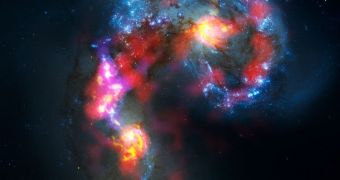Officials at the European Southern Observatory (ESO) report that the massive Atacama Large Millimeter/submillimeter Array (ALMA) radio telescope has finally opened its eyes, and that it is now ready to support scientific investigations.
The instrument is located on the Chajnantor plateau in northern Chile, and currently has only 22 antennas installed. When completed, the observatory will feature 66 high-precision radio antennas.
At this point, the installed instruments are separated by a maximum distance of only 125 meters (410 feet), rather than the proposed 16 kilometers (9.9 miles) that ALMA can support. Future antennas will be placed increasingly farther away from each other, in order to increase its synthetic aperture.
When completed, the array will become the most complex ever built, and will have the ability to work together with other large radio observatories to produce views that were once though impossible to obtain. ALMA will also be capable of using radio interferometry to conduct its investigations.
“Even in this very early phase ALMA already outperforms all other submillimeter arrays. Reaching this milestone is a tribute to the impressive efforts of the many scientists and engineers in the ALMA partner regions around the world who made it possible,” Tim de Zeeuw explains.
The official holds an appointment as the Director General of ESO, which is the European partner in the international ALMA project. The long wavelengths the telescope uses allows it to see objects that are extremely cold, even out of reach for the most sensitive infrared telescopes.
“We are living in a historic moment for science and particularly for astronomy, and perhaps also for the evolution of humanity, because we start to use the greatest observatory under construction at the moment,” ALMA Director Thijs de Graauw adds.
For the first investigation conducted with the telescope – known as the Early Science investigation – astronomers selected the renowned Antennae Galaxies as a target. The system is made up of two colliding galaxies, which are about half-way through the merging process.
“While visible light shows us the stars in the galaxies, ALMA’s view reveals something that cannot be seen in visible light: the clouds of dense cold gas from which new stars form. This is the best submillimeter-wavelength image ever made of the Antennae Galaxies,” an ESO press release reads.
“Massive concentrations of gas are found not only in the hearts of the two galaxies but also in the chaotic region where they are colliding. Here, the total amount of gas is billions of times the mass of our Sun – a rich reservoir of material for future generations of stars,” it concludes.

 14 DAY TRIAL //
14 DAY TRIAL //